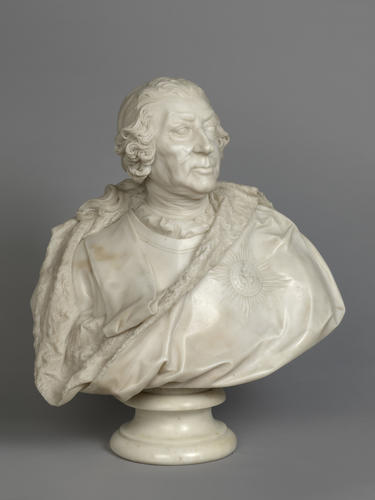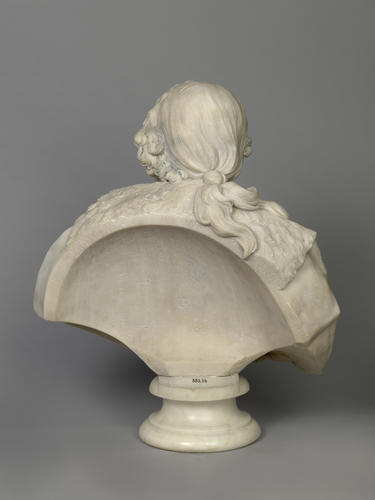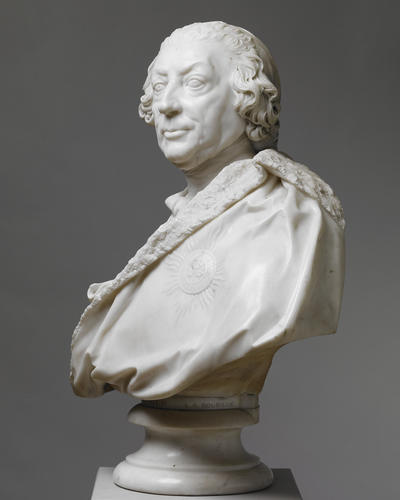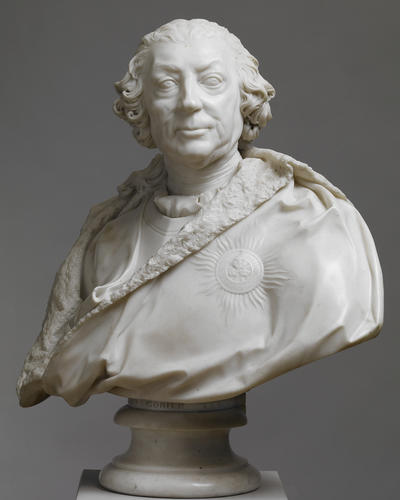-
1 of 253523 objects
Field Marshal John Ligonier when 1st Viscount Ligonier of Clonmell, later 1st Earl Ligonier (1680-1770) 1757-61
Marble | 67.0 x 71.0 x 39.0 cm (whole object) | RCIN 35256




-
A life-size white marble bust of John, Viscount Ligonier, wearing armour beneath a heavy cloak. The sitter's head is slightly raised and turned to his left. His wiry hair falls in dense wavy curls from straight-sided temples. The eyebrows are raised from the centre so as to form an almost right-angled ridge at their upper ends. The pupils, to the left of the eyes, are incised with horizontal crescents. The skin of the face is loose, especially around the mouth, lower lip and double chin. A narrow scar appears at an angle on the proper right cheek. The neck is tightly wrapped with a stock. A wavy fringe of material protrudes from the upper edge of the breastplate, which has a shallow vertical ridge at its centre. Over the sitter's right shoulder the sash of the Order of the Bath, marked with watering, falls down to fold over the edge of the heavy cloak, which is lined with fur. On the outside of the cloak the star of the Bath is lightly carved and inscribed with its motto. The back is smoothly hollowed with some evidence of alteration at the junction with the socle.
Jean-Louis Ligonier was born at Castres near Toulouse, the second son of prosperous Protestant parents. He left France at the age of eighteen in 1698, seeking as his first destination emigre relations in Holland and then making his way via England to Ireland. He was naturalised as an English subject in 1702 and enlisted into the British army, progressing to Captain by February 1703 and remaining a professional soldier for the next sixty years, ending as Field Marshal to which he was appointed in 1766. He served under Marlborough at Blenheim, Ramillies, Oudenarde and Malplaquet, with the Duke of Cumberland in 1745, and as Master General of the Ordnance during the Seven Years War. He became a close confidant of George II, who invested him with the Order of the Bath in person on the battlefield of Dettingen in 1743. Aggressive by instinct and humane as a commander, he has been called the most outstanding general in the British army between Marlborough and Wellington, and in his time shared something of their fame. From the catalogue of Roubiliac's posthumous sale it is clear that a demand was judged to exist for reproductions of this work.
This is a fine portrait of the general, the sculptor apparently relishing the range of textures in the subjects, including aged skin, matted hair, polished breastplate, soft silk ribbon and cloak lining. The bust formerly had a more elaborate socle with armorials, which was replaced at the move to the Grand Corridor in Windsor Castle in 1828. The original does not survive.
Ligonier purchased a fine country house, Cobham Park in Surrey, as well as a townhouse at 12 North Audley Street, and the elaborate socles suggest that both this and RCIN 31614, were intended for a particular setting. The interior of 12 North Audley Street survives and includes a gallery at the rear of the house with a broad niche at each end. It seems highly likely that the busts were intended for those spaces, sitting on their wide, architectural socles.
Louis-François Roubiliac, a native of Lyon, learnt his art in Dresden with Balthasar Permoser and in Paris with Nicolas Coustou. Disappointed by his failure to achieve first prize in the Prix de Rome he moved to London in 1730. Though not himself a Huguenot, he associated with the sizeable expatriate French community of artists and patrons in London, many of whose families had first left France following the withdrawal in 1685 of the protection afforded to Protestants by Henri IV’s Edict of Nantes. Roubiliac made an immediate impact on his craft in Britain and enjoyed a career of more than thirty years, winning fame for his funerary monuments and portrait busts.
The different forms of signature of this bust and that of George II, RCIN 31614 suggest that Roubiliac created his portrait of Ligonier from the life but not that of the King, who may even have died before it was finished. The aged features of this sitter are fixed with unsparing realism. His raised eyebrows which seem to scan the horizon, perhaps across an extensive battlefield, are rendered with astonishing skill.
Text adapted from The First Georgians: Art and Monarchy 1714 - 1760 (2014) and Sculpture in the Collection of His Majesty The King (2025)Provenance
Probably commissioned by the sitter with RCIN 31614, by inheritance to the sitter's daughter Penelope, Mrs Arthur Graham to her daughter Elizabeth, Mrs Francis Lloyd of Gloucester Place, London, by whom presented to George IV at Carlton House, 27 June 1817. It is not known what prompted the gift, Elizabeth surviving until 1844.
Exhibited Society of Artists, 1761.
Installed on the Staircase Landing, Carlton House.
Grand Corridor, Windsor Castle, 12 November 1828.
Queen's Presence Chamber, Windsor Castle, by 1915.
Exhibited in London, 1955, 1967, 1985, 2014.
A terracotta version is in the collection of the National Portrait Gallery, London (acquired 1924 from a Norfolk dealer).
A pencil drawing of the bust by the sculptor Joseph Nollekens is in the collection of the Harris Art Gallery, Preston, probably made in Roubiliac's studio at his posthumous sale. As this bust was already in the possession of the sitter, this depicts one of the four plasters.
A plaster cast of this work was taken in 1962 for the Musee Goya at Castres, Ligonier's birthplace, which was executed in marble by Arthur Saura. -
Medium and techniques
Marble
Measurements
67.0 x 71.0 x 39.0 cm (whole object)
Place of Production
England